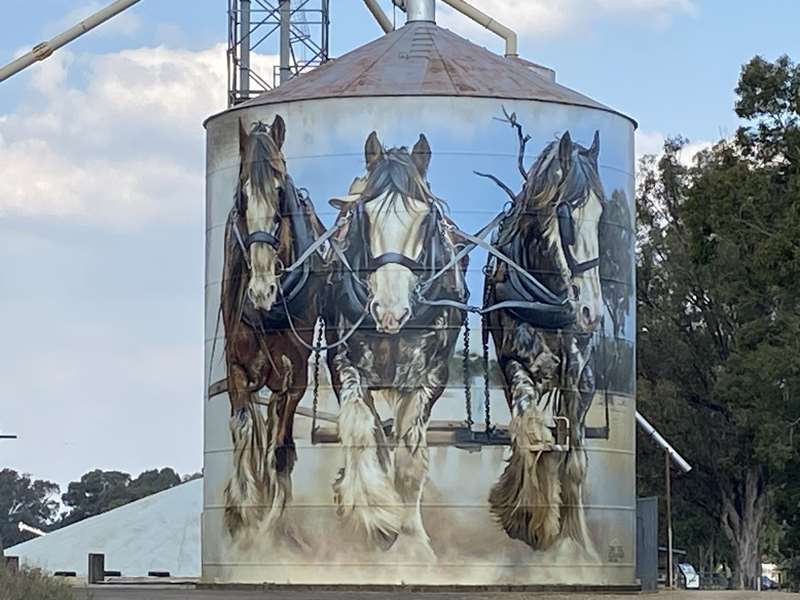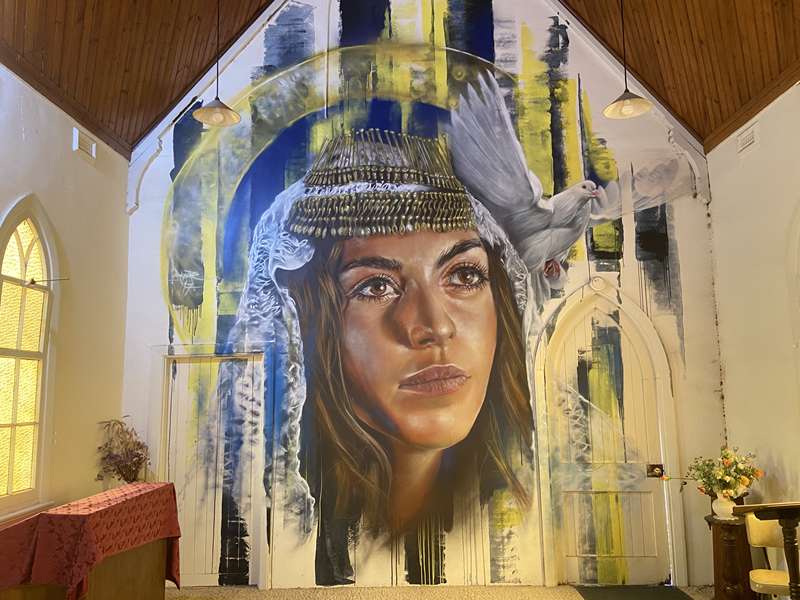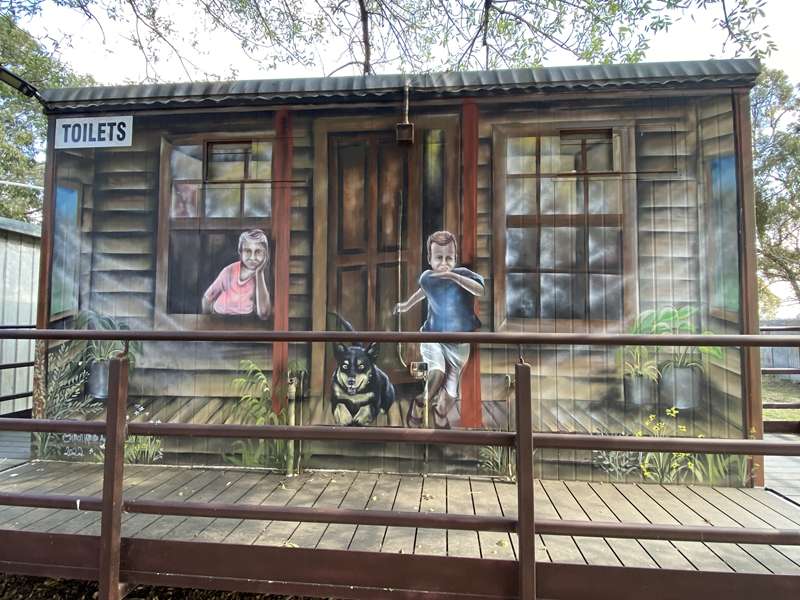Goorambat Silo Art


Goorambat is a small town located 16 km north of Benalla. Three silos have been painted. The first two silos were painted by Jimmy DVate in early 2018 highlighting the Australian Barking Owl and its habitat plus the importance of Agriculture in the district.
The third silo was painted by Jimmy DVate on a return visit in 2019 as a tribute to three Clydesdale horses.

The area around the silos have two shelters with a table.
Barking Owl, Habitat and Agriculture Silo Art
An inspiration for the project is the Australian Barking Owl, which is also known as a Winking Owl. In Victoria, Barking Owls have an estimated population size of fewer than 50 breeding pairs in the wild and are listed as endangered. The Barking Owl is the most threatened owl in Victoria with Northeast Victoria a remaining stronghold for the wild populations.
Iron Bark tree hollows play an important role for both the Barking Owl and its prey which includes gliders. possums, rosellas and bats. Remnant lronbark forest can be seen to the east of the Goorambat township. This is depicted on the second silo where Jimmy has portrayed the Barking Owl's habitat, as well as the importance of Agriculture in the district.
Residents in this area have confirmed the presence of Barking Owls in the past. It is hoped that with greater awareness of the needs of endangered species such as this owl, that we may see them again, or at least retain the beautiful wildlife we enjoy today for future generations.
Clem, Sam & Banjo - The Story of the Horses
Lavereen Clem
Clem was bred by Graeme, Bev and Matt Trewin at Lavereen Stud Goorambat. He was a special colt that was a "dummy" not knowing how to suckle the mare, and had to be bucket raised by Graeme and Bev. The Martin's of Toowoomba had purchased Lavereen Banjo, Clem's older brother from the Trewins and were chasing a working pair. They took Clem on and he proved to be a difficult boy to break in, but once he cottoned on to what was required he soon turned into one of their best and most trusted work horses regularly doing displays at the local museum and won literally thousands of working ribbons at local shows. He just liked his routine.
Lavereen Banjo
Banjo was bred also by Graeme, Bev and Matt Trewin at Lavereen Stud, Goorambat. He is from a family of horses that date back almost 100 years. He was bought by the Martin's of Toowoomba as their breeding stallion and was also a brilliant workhorse known for his extreme laid back attitude at shows, working with mares and geldings without any trouble. He has been the QId Ploughing Champion, Master Horse Handler winner with Dave and also did well in the show ring. Clem and Banjo's brother and sister are still on the stud just down the road.
Coolibah Ridge Samuel
Sam was bred by Dave and Nicola Martin of Coolibah Ridge Clydesdales in Toowoomba. When Sam was born they gave him to their son, who broke him in and worked him at just 4 years of age. He is Banjo's grandson.
Clydesdale Horses - In Collaboration with the Benalla Wall to Wall Festival
Clydesdale horses have always been the backbone of the Goorambat farming community. This traditional breed of horse from Scotland has been used for farming from the time of the first settlers until long after the first tractor arrived in Goorambat in 1924, and to this day are one of the most beloved work animals of the district.
As tractors took over Clydesdale numbers dropped dramatically but were retained by some who loved these gentle giants.
The township chose to commission Jimmy DVate to paint a team of these magnificent animals, including two bred here by Graeme and Bev Trewin of the prize-winning Lavereen Stud. Lavereen Clem is on the left and Lavereen Banjo (on the right), along with Sam (centre) who is the grand-son of Banjo. The Lavereen Stud, founded in Goorambat in 1920 by Graeme Trewin's grand-father, James T Martin, is the oldest stud continuing on the same property in Australia.
Graeme became involved in running the stud at just 18 years old, when his father, Tom, entered Parliament. At this time, harvesters drawn by Clydesdale horses were commonly used, with only a few people moving to motorised farm equipment. The last working draught horses in the area belonged to the Todd family (see right). The Lavereen Stud is currently run by Graeme's son Matthew.
Graeme's 3 x great grandmother, Mary Devitt, migrated to Australia in the mid-1850's from 'Lavereen' in County Clare, Ireland. Her grandson, James Martin of Devenish named the stud after her. Meanwhile John and Caroline Trewin (nee Cooper) moved to Goorambat in a bullock wagon in the late spring of 1877, along with their 6-year old son Herbert, settling east of where the Goorambat township was to be. They con-structed a dwelling of galvanised iron and palings on their 194 acre piece of leased land, naming it "Hillside". Caroline's parents owned an adjoining property to the north - "Watch Hill". Many of the Trewin family horses have since won prestigious prizes, including at Royal Melbourne Show to which the horses were transported by train each year from Goorambat.
The three Clydesdale horses in this silo painting now belong to the Martin family of Toowoomba. The painting has been drawn from an original photograph taken by Bob Britcher AFIAP AAPS PSQA of Queensland.
Thomas Campion Trewin MLA - Victoria
Tom Trewin was one of Goorambat's 'famous sons'. Born in Goorambat in 1914 to farmer father, Perce, and a schoolteacher mother, Ellen, he first attended Gdorambat State School with his twin brother (also Perce), then left Benalla High School at 14 to commence work as a share farmer. He married May Martin, daughter of a local Clydesdale breeder in 1940, and they worked the Martin family farm. He entered Parliament as the local National Party member for Benalla in 1961 where he remained until his retirement in 1982. He was known as an extremely hardworking and popular MP who was liked by everyone across the parties, and throughout his career remained a Rotarian, member of the Lions Club, and Vice-President of the Benalla Agricultural & Pastoral Society, as well as Vice-President of the North Eastern district council of the Victorian Wheat & Wool-growers Association, a member of the rural fire brigade, and served on a number of school councils. In lArliament he was the Nationals' inaugural spokesperson on agriculture, achieving water storage construction throughout NE Victoria, and was associated with legislation to establish the wheat stabilisation scheme and to improve systems for wool and livestock marketing.
On top of this he was a keen sportsman, being President of Benalla Football Club, President of the Benalla & District Cricket Association for over 20 years, President of the Victorian Country Cricket Association and was referred to as "Benalla's Mr. Cricket". The Tom Trewin Stand in Benalla rose garden was named after him. He also had a lifelong interest in the Anglican Church, acting as church warden and representative on the church synod.
Most importantly to the Goorambat community was his passion for breeding and showing Clydesdale horses, he became an authority on them, judging all over Australia. It was noted that in his parliamentary speeches it was very rare to find one which did not include a reference to these magnificent beasts. Today the stud is the oldest surviving Clydesdale stud in Australia.
Tom passed away in 1992 and is buried in Devenish Cemetery, it is said that the funeral procession was so long that the last cars were leaving Benalla as the hearse arrived at the cemetery, nearly 25km away.
Other Artwork in Goorambat
Uniting Church Mural by Adnate
97 Hall Road, Goorambat

'Sophia' came into being in 2017 when the Uniting Church congregation in Goorambat were approached to host a mural inside the church itself as part of the Wall to Wall festival. The mural had to be relevant to the culture and ethos of the church community and of a quality that would enhance the church precinct. After some concept images were discussed with artist Adnate it was suggested, inspirationally, that the subject might depict 'Sophia' the female aspect of the Holy Spirit. This traditions draws on the spirit of God as it manifested in the Old Testament times and the post Pentecostal period.
Goorambat Toilet Block Mural by Simon White
53 Hall Road, Goorambat

Nankeen Kestrel Mural by Adnate
19 Hall Road, Goorambat

Location
43 Halls Road, Goorambat 3725 View Map








